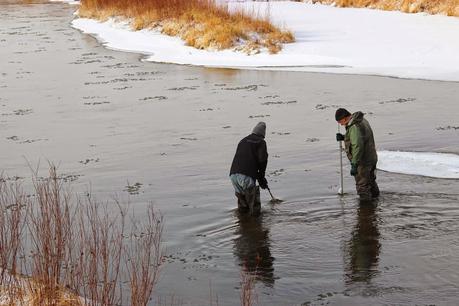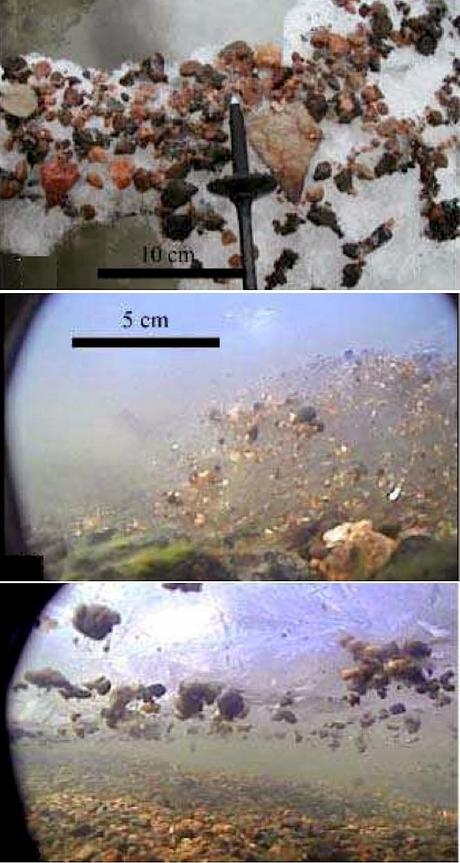 It was the first of February, 8:30 AM, and 17º F after a cloudy night with light snow. When I reached the river, I saw two men with poles standing in the water as ice floated by. What were they doing?! Fishing? hunting crawdads? collecting garbage? maybe playing ice golf, an ancient Scandinavian sport?
It was the first of February, 8:30 AM, and 17º F after a cloudy night with light snow. When I reached the river, I saw two men with poles standing in the water as ice floated by. What were they doing?! Fishing? hunting crawdads? collecting garbage? maybe playing ice golf, an ancient Scandinavian sport?
Will this be the final putt?

The men intently studied the river as my lanceleaf cottonwood tree stood by.
This month’s tree-following post was to be about my search for a new tree, but the cottonwood I've followed for a year now led me to two unexpected and interesting things. First there were the men who were taking photos of ice on the river bed.
They used a GoPro action camera – the kind folks wear to record adrenalin-inducing activities.
Ice on the river bed? How can that be? Ice floats, being less dense than water. True ... but as I now know, under the right conditions a special kind of ice forms – anchor ice. It’s really interesting and worth keeping an eye out for. I’m glad I asked those guys what they were doing.Cold nights are best, well below freezing. Where the river is fast-moving and shallow, water may become super-cooled and stay liquid below its normal freezing temperature. The sand, gravel, rocks, etc. that it’s flowing over also cool to that temperature. The water is moving right along so surface ice doesn't form, but floating crystals (frazil) freeze out. They stick to material on the river bed and to each other, making gray-green soft slushy ice. When the day begins to warm, anchor ice begins to break free and float downstream. Soon it’s all gone. [Here’s a summary with clear explanations, and another in PDF format.]


Gray-green detached anchor ice floating downstream.
For years I’ve watched murky globs of ice float down the river on cold mornings. I always thought they had broken off from ice along the river margins. Now I know better. The things you learn when you follow a tree!Anchor ice was pretty minimal that day and has been for most of this unusually-mild winter. But it can be dramatic with significant impacts, like creating dams and scouring river beds. “Seeing is believing” so have a look at this anchor ice video – a “nature treat for the day” from the northeast USA.--- ✿ ✿ ✿ ✿ ✿ ✿ ✿ ---The second thing of interest is actually quite amazing ... my tree is blooming in February!
Cottonwood in full bloom; click on image to see fringed bracts, young ovaries and stigmas as in diagram below.




Mehitabel (by Don Marquis).
More about anchor ice in the Laramie River:Kempema, E, Ettema, R, and McGee, B. 2008. Insights from anchor ice formation in the Laramie River, Wyoming. 19th IAHR International Symposium on Ice.Kempema, E, and Ettema, R. 2010. Anchor ice rafting: observations from the Laramie River. River Research and Applications 27:1126-1135.
